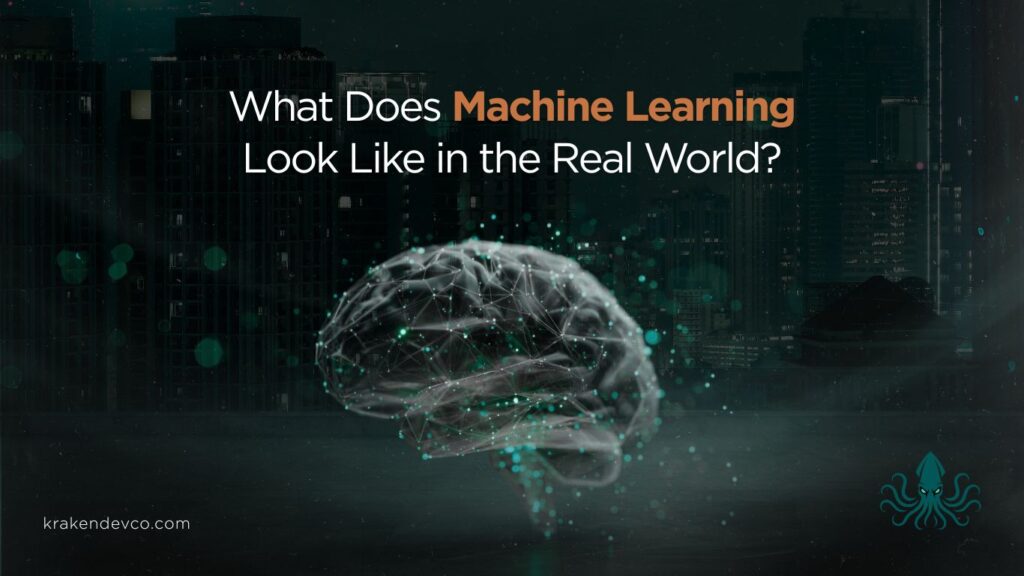
Ever asked your phone a question and got the perfect answer? That’s machine learning at work. But what else is it powering behind the scenes?
At Kraken Dev Co, we don’t just build websites—we engineer systems. Machine learning (ML) isn’t some theoretical buzzword for us. It’s core infrastructure, silently reshaping everything from logistics algorithms to real-time fraud detection. If you’re wondering what machine learning looks like in action, here’s the no-nonsense breakdown—technical, strategic, and tied directly to business value.
What Is Machine Learning?
Machine learning is a form of artificial intelligence that trains systems to learn patterns from data and improve over time—without manual reprogramming. Instead of following fixed rules, ML models evolve. They detect signals in high-volume datasets and optimise their output based on feedback.
Key advantage: adaptability. The more data a system consumes, the sharper its predictions become.
Machine Learning, AI, and Deep Learning—What’s the Difference?
Clear terms prevent sloppy implementations.
- Artificial Intelligence (AI): The umbrella term for machines simulating human-like intelligence.
- Machine Learning (ML): A branch of AI that uses data to teach systems how to make decisions.
- Deep Learning: A subfield of ML, leveraging layered neural networks to process unstructured data like images or audio.
They build on each other. But each has different applications and infrastructure demands.
How Machine Learning Actually Works
ML isn’t magic—it’s a structured pipeline:
- Data Collection: Raw input from logs, APIs, sensors, forms.
- Preprocessing: Cleaning, deduping, normalising—removing garbage.
- Model Selection: Choosing the right algorithm:
- Linear Regression: For predicting continuous outputs.
- Decision Trees: For classification problems.
- Neural Networks: For nonlinear, high-dimensional data.
- Linear Regression: For predicting continuous outputs.
- Training: Feeding data through the model and correcting based on error rates.
- Evaluation: Metrics like F1-score, accuracy, and precision assess performance.
- Optimisation: Hyperparameter tuning sharpens outcomes.
- Deployment: Integrated into APIs, apps, or embedded systems—then monitored and retrained as needed.
Core Types of Machine Learning
Understanding the four dominant training paradigms is critical:
- Supervised Learning: Trains on labelled data (e.g., spam detection).
- Unsupervised Learning: Finds structure in unlabelled data (e.g., customer segmentation).
- Semi-Supervised Learning: A blend—small labelled datasets guiding vast unlabelled ones.
- Reinforcement Learning: Learns by trial and error (e.g., autonomous navigation).
Where Machine Learning Is Already Embedded
You’re using ML every day—even if you don’t notice.
- Facial Recognition: From biometric logins to medical imaging diagnostics.
- Product Recommendations: Amazon, Netflix—every scroll is algorithmically calculated.
- Email Filtering: ML powers spam detection, auto-categorisation, and predictive replies.
- Finance: Credit scoring, fraud detection, loan approvals—all ML-enhanced.
- Social Platforms: Timelines, content moderation, engagement tracking.
- Healthcare: Cancer scans, wearable alerts, predictive diagnoses.
- Voice Assistants: Speech-to-text, command interpretation, contextual recall.
- Logistics & Transport: Google Maps, Uber, fleet routing, and autonomous driving.
- Cybersecurity: Real-time anomaly detection, intrusion prevention.
- Algorithmic Trading: Millisecond-level trade execution based on sentiment analysis.
- Customer Support: AI-driven chatbots resolving tickets 24/7.
- Smartphone Apps: Camera filters, battery usage prediction, real-time translation.
- Assistive Tech: Speech generation, fall detection, smart guidance tools.
Business-Driven ML Outcomes
This isn’t experimental tech. It’s driving enterprise KPIs.
- Automation: Replaces manual workflows—think form reviews, document tagging, and ticket routing.
- Personalisation: Dynamic content, tailored ads, contextual messaging.
- Operational Intelligence: Predictive dashboards, early warnings, anomaly detection.
- Fraud Defence: Pattern recognition at scale, zero-delay alerting.
- Resource Optimisation: From inventory to energy grids—ML finds waste and eliminates it.
Know the Limits—Not All ML Is Smart
ML is powerful, but not perfect:
- Bias Risk: Garbage in, garbage out. Flawed training data leads to discriminatory outcomes.
- Infrastructure Load: Model training, especially for deep learning, demands serious compute.
- Domain Expertise Gap: ML without context leads to false correlations and wrong conclusions.
- Regulatory Overhead: ML systems that handle personal data must align with GDPR and similar frameworks.
The ML Stack: Tools That Build the Future
At Kraken Dev Co, we engineer for scale. Here’s the toolkit that makes ML work in production:
Languages
- Python (dominant)
- R (statistics-heavy pipelines)
Libraries
- NumPy, Pandas: Core data handling
- Matplotlib, Seaborn: Visualisation
- Scikit-learn: Traditional ML models
- TensorFlow, PyTorch, Keras: Deep learning architecture
Cloud & MLOps Platforms
- Google Vertex AI
- BigQuery ML
- MLflow
- Kubeflow
ML Careers—The Talent Behind the Stack
ML isn’t run by black boxes. It’s run by people with technical range.
- Data Scientists: Extract and interpret insights.
- ML Engineers: Build and deploy model pipelines.
- Research Scientists: Develop next-gen algorithms.
Core skills include:
- Programming (Python, R)
- Applied mathematics
- Statistics
- Model interpretability
- Deployment and MLOps
Want to Start? Here’s How
Machine learning is technical—no shortcuts. But the learning path is clear:
- Learn Python and mathematical foundations.
- Master core ML algorithms: regression, classification, clustering.
- Build real projects (email classifiers, image labellers).
- Use platforms like Fast.ai, DataCamp, or Coursera.
- Contribute to GitHub repos, follow industry blogs, and join ML forums.
Final Take: Machine Learning Is Already Operational
Machine learning isn’t next—it’s now. It’s how fraud gets stopped in real time, how ads find you before you search, and how your phone knows what you meant to say.
At Kraken Dev Co, we don’t just follow ML trends. We build infrastructure that learns, adapts, and performs at scale.
Machine learning isn’t coming for the future. It’s already part of your stack. The real question is—are your systems smart enough to keep up?



